Sumac Trees: Types, Leaves, Berries (Pictures) – Identification and Planting Guide

Sumac (genus Rhus) is a group of flowering small trees and shrubs. Sumacs are identified by their fern-like pinnate leaves, conical clusters (panicles) of white or green flowers, and fuzzy red berries. In the fall, sumac trees and shrubs turn brilliant autumn shades of red, orange, or purple. Trees and shrubs in the genus Rhus grow between 3 and 33 ft. (1 – 10 m).
Sumac trees such as the staghorn sumac (Rhus typhina), smooth sumac (Rhus glabra), and fragrant sumac (Rhus aromatica) produce edible red berry-like drupes. There is also a shrub called the poison sumac (Toxicodendron vernix), which produces small poisonous white berries. But it is easy to tell edible sumacs apart from the poison sumacs by looking at the berries, leaves, and twigs.
This article is a guide to identifying the common types of sumac trees and shrubs. Descriptions and pictures of sumac tree leaves, flowers, and berries will help you recognize these plants in landscapes. Due to their spectacular fall colors, sumac shrubs and trees are popular garden landscaping plants.
About Sumac Plants (Trees and Shrubs)

Sumacs are flowering trees and shrubs used in landscaping gardens due to their beautiful autumn foliage
Sumacs are flowering woody trees and shrubs belonging to the genus Rhus and cashew family Anacardiaceae. There are around 150 species of sumac, with 14 being native to the US. Sumac trees and shrubs grow in most soil types and are often seen growing in dry and poor soil.
Native North American sumac trees grow in USDA zones 3 through 9.
Hardy sumac trees, like the staghorn sumac, have a fast growth rate—growing as much as 24” (60 cm) a year.
A characteristic of sumacs is their suckering growth habit. This feature means that sumacs can grow as multi-stemmed shrubs if you don’t remove the suckers.
Most species of sumac, like the staghorn sumac, fragrant sumac, and smooth sumac, are deciduous trees that lose their leaves in the fall. The native tobacco sumac (Rhus virens) is an evergreen variety with glossy green, leathery leaves. Most sumac trees have a dome-shaped, spreading crown.
Sumac trees have plenty of ornamental value for front or backyards. Sumac are popular landscaping trees that grow as beautiful hedges, borders, or screens. Some of the sumac tree varieties work as attractive specimen trees.
A sumac tree has decorative appeal throughout the seasons. In spring, cone-like green or white flowers appear, followed by clusters of red edible berries, before the sumac tree’s foliage transforms from deep green color into magnificent red, orange, reddish-purple, and purple colors.
Sumac Leaves
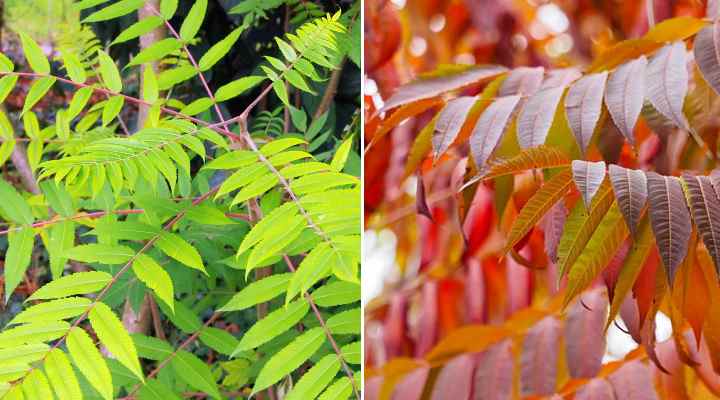
Sumac leaves have stunning autumn colors
Leaves on sumac trees are identified as pinnately compound, glossy green leaves that look like fern leaves. Each feather-like sumac leaf is made up of 3 to 31 elongated lanceolate leaflets with serrated margins. Sumac leaves grow between 16” and 24” (40 – 60 cm) long.
Although most sumac species leaves are pinnate leaves, some species of sumacs have broad leaves with shallow lobing. For example, leaves on the fragrant sumac (Rhus aromatica) have a broadly ovate shape and only have three leaflets per compound leaf.
Sumac landscape trees are known for the striking autumn colors of their leaves. In the fall, sumac foliage turns impressive red hues. It’s not uncommon to see sumac shrubs or trees with deep orange colors or warm yellow shades.
Sumac Flowers

Sumac flowers
Sumac flowers are tiny, five-petaled blossoms that form conical, creamy-white or green clusters. Each sumac panicle can have thousands of flowers. Flower clusters measure 12” (30 cm) long and 2” to 4” (5 – 10 cm) across. Sumac trees bloom in spring, and the flowers persist throughout the summer.
Sumac Berries
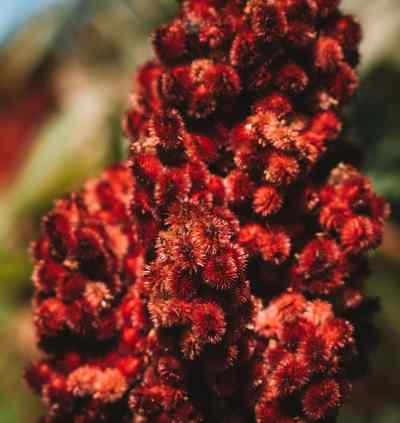
Sumac fruits are berry-like drupes
Sumac trees are known for their bright red, berry-like drupes that grow in large cone-like clusters. Each small sumac fruit measures 0.16” (4 mm) across. The sumac berries have characteristic fine hairs, giving the red drupe a fuzzy appearance. The clusters of crimson-red sumac fruits grow up to 12” (30 cm) long.
Although they look like berries, sumac fruits are drupes—fruits with a seed in the middle like a peach or apricot. The red sumac drupes have a citrusy flavor with a distinct tangy taste and are high in vitamin C. Sumac berries are also used to create sumac spice, popular in Middle Eastern cuisine.
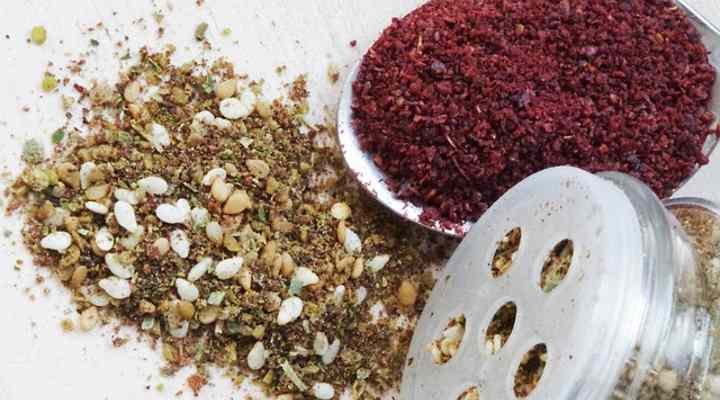
The red sumac spice is mainly cultivated from the Syrian sumac (Rhus coriaria) and is commonly used in Middle Eastern cuisine and other spice mixtures such as za’atar (on the left)
A handy tip to identify edible sumac berries: Edible sumac berries are always crimson or bright red. Poisonous sumac berries are green in the summer and white in the winter.
Poison Sumac vs. Sumac
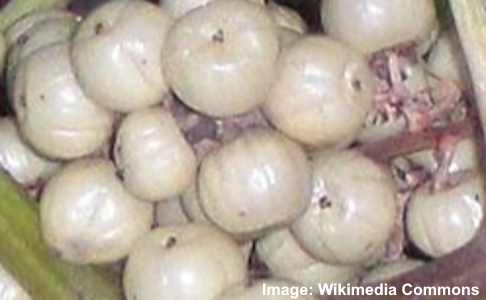
Poison sumac fruit
The easiest way to identify poison sumac (Toxicodendron vernix) apart from the edible sumac species is by the berries, leaves, and twigs. Poison sumac berries are typically white, whereas edible sumac berries are bright red. The leaves on a poison sumac shrub have smooth margins, whereas nonpoisonous sumac plants have serrated margins. Additionally, poison sumac twigs are smooth, not hairy like typical sumacs.
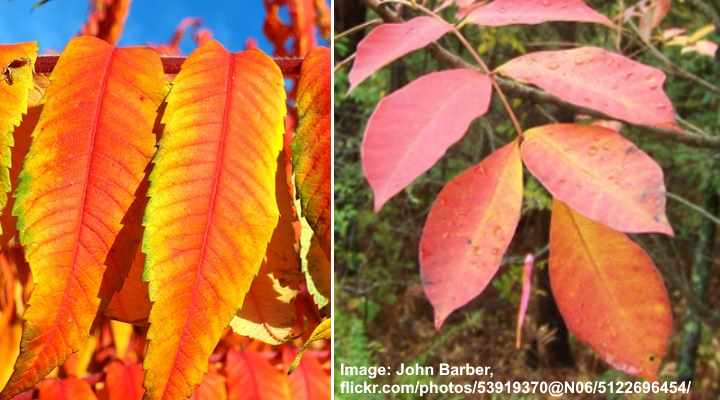
The leaves of sumac trees (Rhus) have serrated margins (left) whereas poison sumac has smooth margins (right)
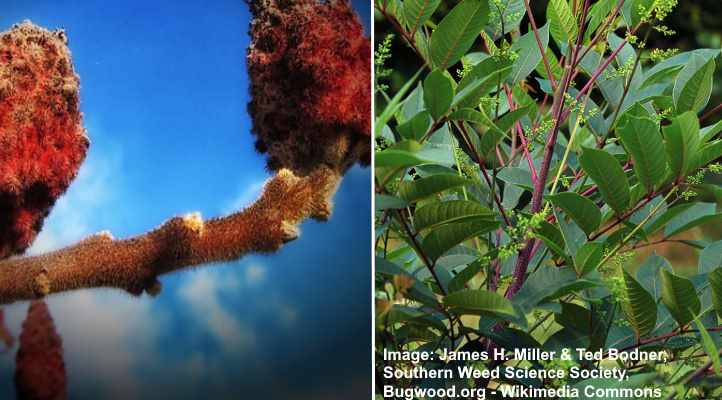
The twigs of sumac trees (Rhus) have fine hairs (left) whereas poison sumac has smooth twigs (right)
Another identifying feature of sumac shrubs with edible red berries is that they typically grow in dry areas. On the contrary, poison sumacs grow in wet areas or swamps. Also, poison sumac tends to grow as a single, stand-alone plant, not in groups like staghorn sumacs.
Sumac Tree Identification
Identify sumac trees by looking at the leaves, flowers, and berries. Sumacs have large, characteristic fern-like leaves made up of 3 to 31 leaflets. Another identifying feature of sumacs is their cone-shaped white or green flower panicles, 24” (60 cm) long that mature into clusters of red fuzzy berries.
How to Grow Sumac Plants
Sumac trees and shrubs are versatile plants that grow in most conditions. To ensure the plant grows well, plant sumacs in well-drained soil and full sun to partial shade. Once sumacs are established, the plants tolerate drought but grow fastest when watered regularly. Grow sumac trees in USDA zones 3 to 9.
Types of Sumac Trees (With Pictures)
Let’s look in more detail at the varieties of sumac trees suitable for garden landscapes. Looking at the identifying features of sumac trees will help you choose the best types if you want to add these beautiful plants to your garden landscape.
Staghorn Sumac (Rhus typhina)
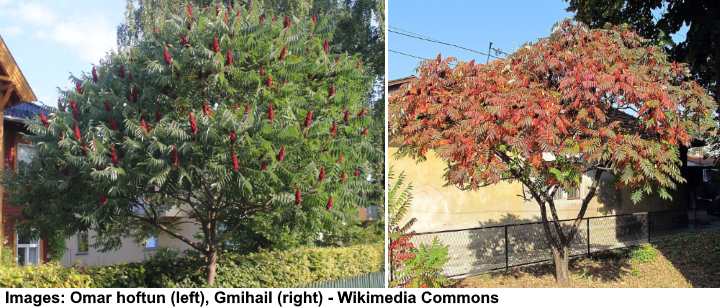
Staghorn sumac trees (Rhus typhina)
Staghorn sumac (Rhus typhina) is a small flowering tree or large shrub with large pinnate leaves, greenish-white flowers, and bright red clusters of drupes. Staghorn sumacs grow between 15 and 25 ft. (4.5 – 7.6 m) tall and up to 30 ft. (9 m) wide. The small tree has an open, spreading crown.
The staghorn sumac tree grows in USDA zones 3 to 9. The hardy, versatile, fast-growing tree grows in a wide range of soils if there is good drainage. The sumac plant reproduces through root suckers. You can find staghorn sumacs in the wild growing in Eastern North America.
The common name of Rhus typhina comes from the fact that the forked branches resemble a stag’s horns. Also, the fine, velvety feel of the branches and twigs seem like “antlers in velvet.” Other names for the staghorn sumac include velvet sumac and vinegar sumac.
Staghorn sumac tree flowers bloom from spring through summer. Each cluster of greenish-white flowers grows up to 8” (20 cm) long and 6” (15 cm) wide. The flowers don’t have any distinctive scent, unlike the leaves that have a citrusy aroma when crushed.
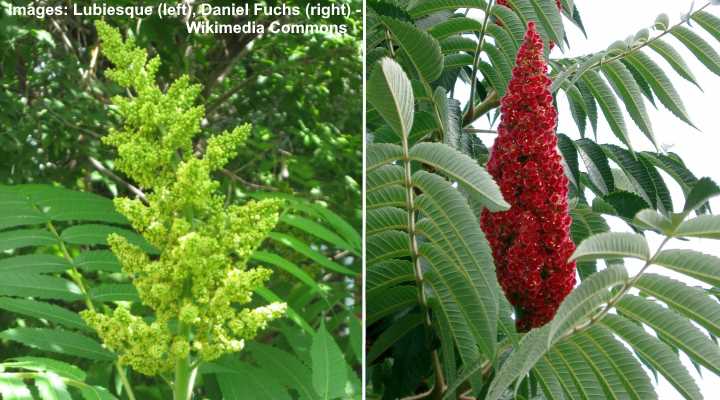
Staghorn sumac flowers at early stage of blooming (left). The female flowers form a cluster of round, fuzzy fruit (right)
Sumac leaves: Staghorn sumac lemon-scented leaves are pinnately compound with up to 31 lanceolate, serrated leaflets measuring 3” to 6” (7.5 – 15 cm). The fern-like compound leaves measure up to 24” (60 cm) long. In the fall, staghorn sumacs turn deep red, orange, or golden-yellow.

Staghorn sumac leaves
Sumac berries: Staghorn sumac red berries are showy clusters of brightly colored edible drupes. The fuzzy red berries emerge in late fall and persist through winter until spring. The sumac fruits turn deep red in winter, giving the tree ornamental value.
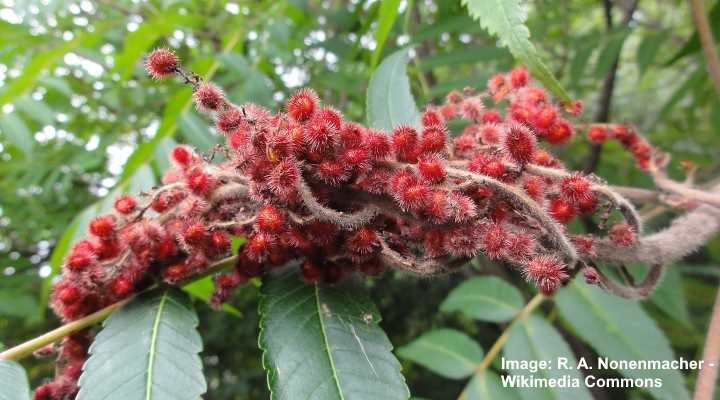
Staghorn sumac fruit
Sumac identification: To identify staghorn sumac trees, look for large feather-like green leaves, cone-shaped clusters of green-white or red flowers, and red berry clusters that stay on the tree from fall until spring.
Smooth Sumac (Rhus glabra)
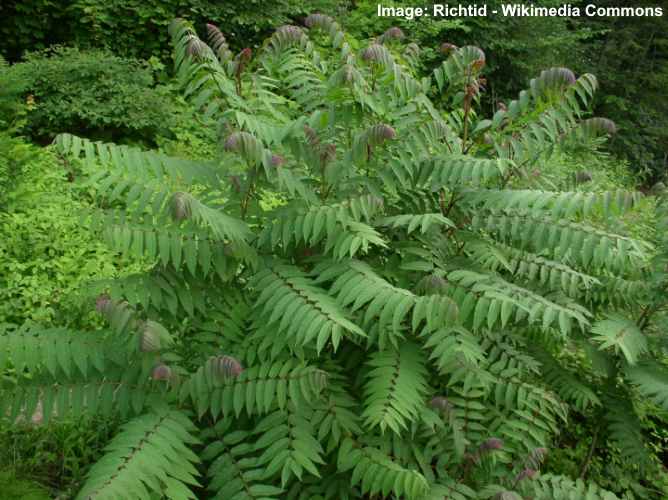
Smooth sumac shrub (Rhus glabra)
Smooth sumac (Rhus glabra) is a large deciduous shrub with an open, spreading crown consisting of shiny fern-like leaves, conical greenish-yellow flowers, and dark red berries. Smooth sumac shrubs turn stunning red and orange colors in the fall. Smooth sumac plants grow between 8” and 15” (2.4 – 4.5 m) tall and wide.
Thriving in USDA zones 3 to 9, the smooth sumac is a low-maintenance landscaping plant. The decorative shrub thrives in full sun to partial shade and tolerates drought.
Smooth sumac shrub flowers grow in erect panicles of dense clusters consisting of tiny green flowers. The cone-shaped clusters grow between 4” and 10” (10 – 25 cm) tall and bloom from spring until the end of summer.
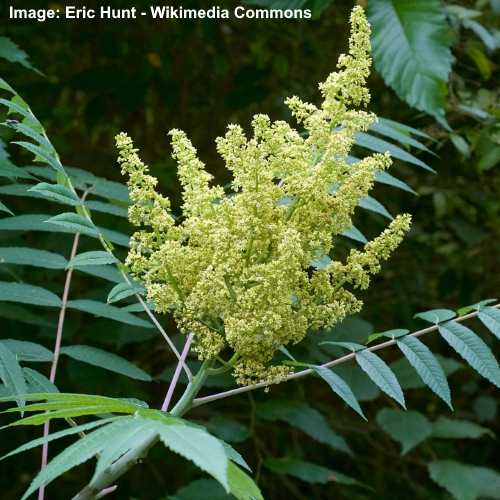
Smooth sumac flowers and leaves
One way to identify a smooth sumac shrub is by its hairless, reddish bark. The common name of Rhus glabra—smooth sumac—comes from the smooth feel of the twigs. Most sumacs have fuzzy, velvety bark.
This hairless bark and twigs can make smooth sumac shrubs challenging to tell apart from poison sumac (Toxicodendron vernix). It’s vital to remember that poisonous sumacs have white berries and leaves with non-serrated margins.
Sumac leaves: Smooth sumac leaves are large, dark green compound leaves consisting of 11 to 31 pointed leaflets. Like most sumacs, the individual leaflets have serrated margins and an oblong-lanceolate shape. The leaves grow 12” to 20” (30 – 50 cm) long and up to 6” (15 cm) wide.
In the fall, smooth sumac leaves turn burgundy or orange.
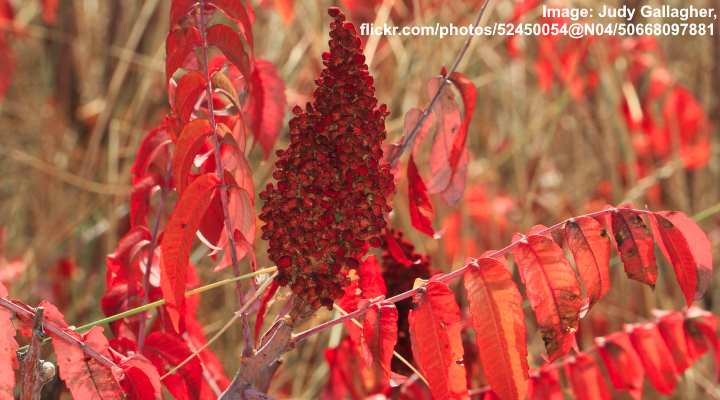
Smooth sumac fruit and autumn foliage
Sumac berries: Smooth sumac berry-like drupes grow in clusters of red fruits that turn maroon-brown throughout winter. Like all edible sumac fruit, the berries have a furry appearance and tangy, citrusy taste.
Sumac identification: To identify a smooth sumac plant, look for hairless, smooth twigs, large pinnate leaves, clusters of greenish-yellow flowers, and red fall berries that persist until spring.
Fragrant Sumac (Rhus aromatica)
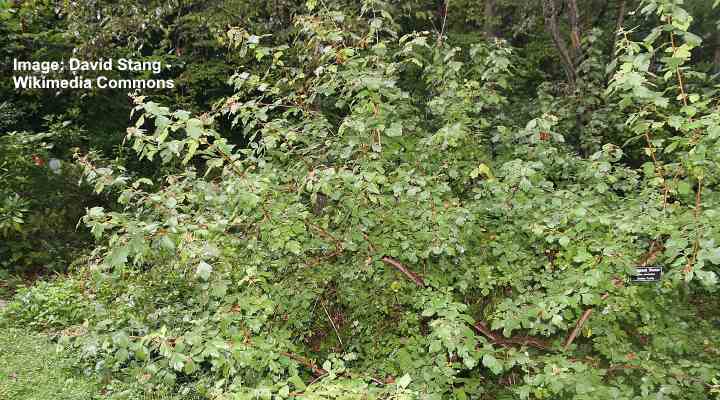
Fragrant sumac (Rhus aromatica) shrub
Fragrant sumac (Rhus aromatica) is a small, low-growing woody shrub with aromatic glossy green smooth leaves, small clusters of flowers (catkins), and small red berries. In the fall, fragrant sumac shrubs turn beautiful shades of orange, red, yellow, and purple. Fragrant sumacs grow 2 to 6 ft. (0.6 – 1.8 m) tall and 10 ft. (3 m) wide.
Like all sumac varieties, fragrant sumac shrubs are cold-hardy plants that survive in USDA zone 3 to 9. Growing in full sun or partial shade, the small shrub adapts to various soil types and can survive periods of drought.
Fragrant sumac flowers are small clusters of showy yellow spring flowers. The catkins grow up to 3” (7.5 cm) long and 1” (2.5 cm) wide. One of the characteristic features of fragrant sumacs is their pleasant aromas. The flowers, twigs, and leaves give off a lemony citrus scent.
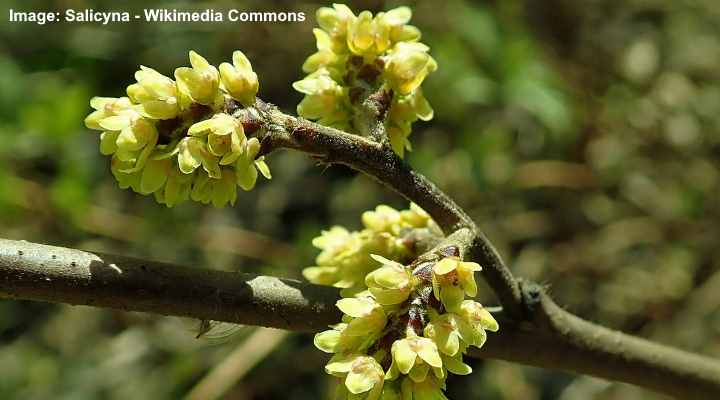
Fragrant sumac flowers
As a small shrub, the aromatic sumac grows as thick ground cover for full sun or border plants. The pretty yellow sumac flowers attract pollinators to gardens. You can grow this ornamental landscape shrub in poor soil, dry soil, or clay soil.
Sumac leaves: Fragrant sumac leaves are ovate-shaped leaves, unlike most species of sumac plants. The trifoliate leaves have three broad leaves. The outer leaves are ovate, and the larger middle leaf is typically spatula-shaped. Fragrant sumac leaves grow up to 3” (7.5 cm) long.
In the fall, fragrant sumac leaves turn shades of orange, red, or reddish-purple.
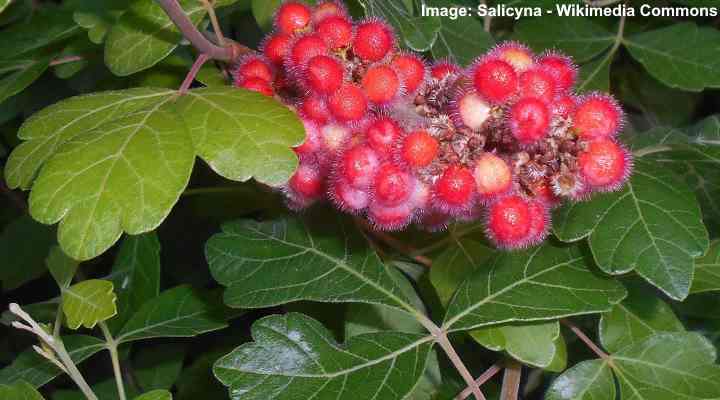
Fragrant sumac fruit and leaves
Sumac berries: Fragrant sumac berries are small and red with a hairy appearance. The fuzzy red drupes appear on the bushy aromatic shrub in late summer and provide winter color in otherwise barren landscapes.
Sumac identification: To identify fragrant sumac shrubs, look for ovate leaves growing in groups of three. The tiny yellow flower clusters grow on the ends of twigs and develop into fuzzy red berries in late summer.
Other Varieties of Sumac Plants
Let’s look at some of the identifying features of other trees and shrubs in the sumac family of flowering woody plants.
Winged sumac (Rhus copallinum)
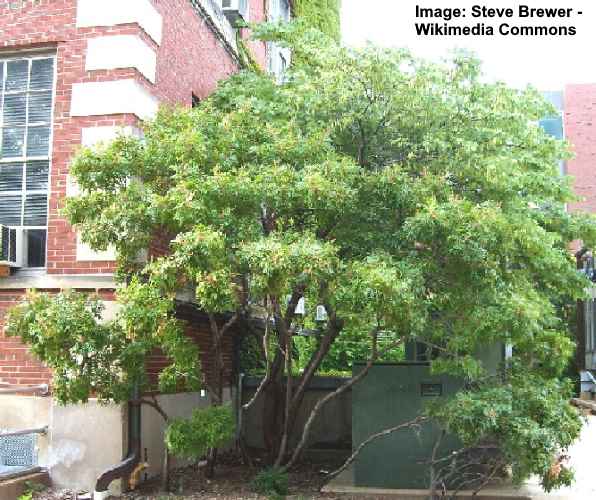
Winged sumac (Rhus copallinum) multi stemmed tree
Winged sumac (Rhus copallinum) is a medium-sized multi-stemmed deciduous shrub or small tree. The native sumac shrub is identifiable by its large, pinnately compound leaves, yellow flower clusters, and red fall colors. Growing in USDA zones 4 to 9, the sun-loving shrub grows between 7 and 15 ft. (2.1 – 4.5 m) tall and up to 20 ft. (6 m) wide.
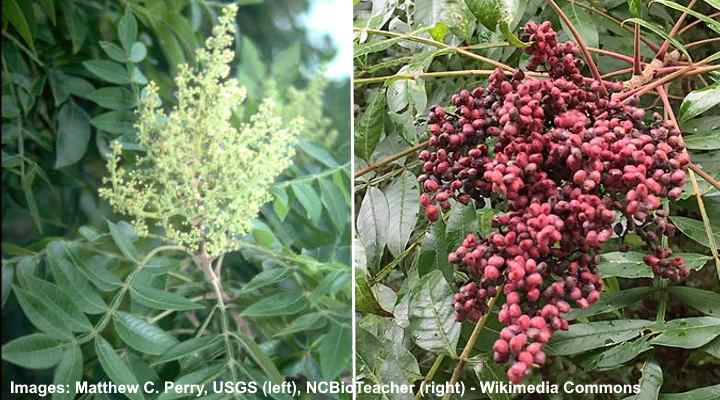
Winged sumac flowers and fruit
Winged sumac has fast growth and the typical characteristic features of sumac plants. Clusters of pale yellow, feathery flower panicles give way to fuzzy red berries that last until late winter. The stunning fall colors are vibrant shades of orange and red.
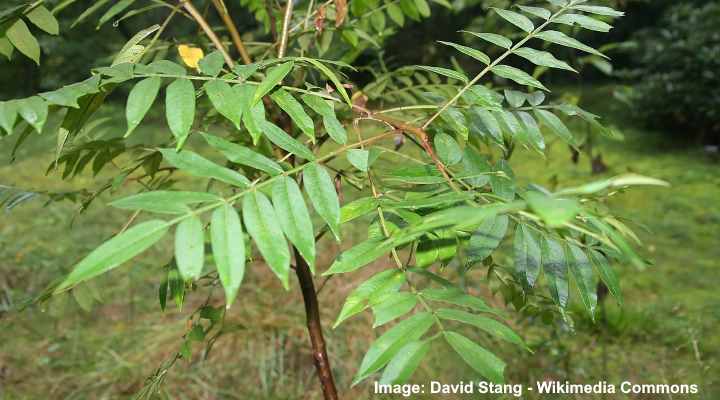
Winged sumac leaves
Other names for winged sumac shrubs include dwarf sumac, shining sumac, and flameleaf sumac.
Evergreen Sumac or Tobacco Sumac (Rhus virens)

Evergreen sumac (Rhus virens) tree
Evergreen sumac (Tobacco sumac) is a small tree or shrub. The fast-growing evergreen sumac grows between 8 and 12 ft. (2.4 – 3.6 m) tall with spreading branches. Evergreen sumac leaves are thick and leathery and have five to nine leaflets on each compound leaf.
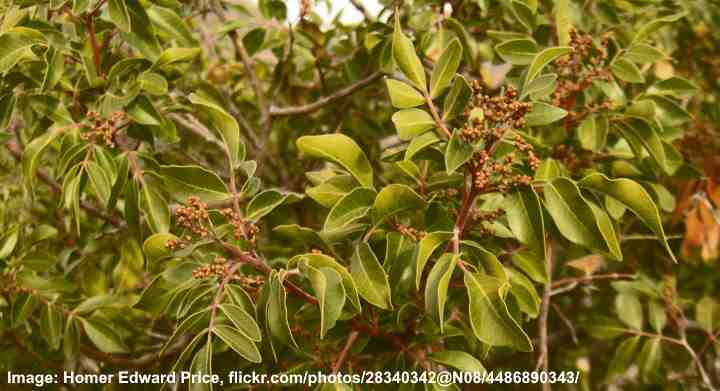
Evergreen sumac leaves
Also called Lambrisco or Lentrisco, the evergreen sumac is identified by 2-inch (5-cm) clusters of white flowers growing at the end of branches. Fuzzy red oval drupes appear in early fall.
Although being called an evergreen shrub, the sumac plant drops its leaves after winter. However, unlike deciduous sumac, this attractive shrub stays green during winter. New leaves appear rapidly after the shrub loses its foliage.
African Sumac (Searsia lancea or Rhus lancea)
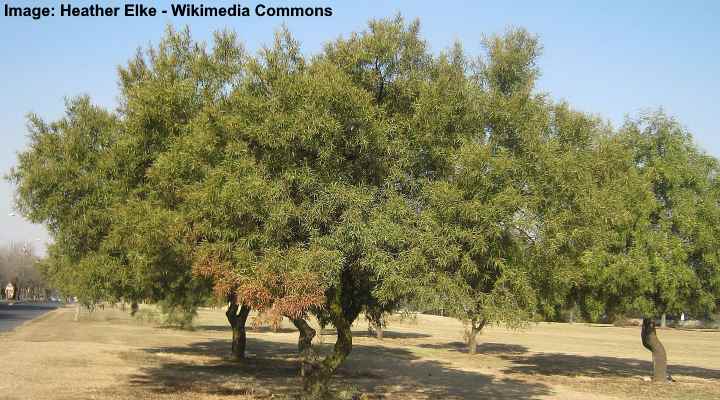
African sumac trees (Searsia lancea / Rhus lancea)
The African sumac is a medium-sized shrub-like evergreen tree with unusual strap-like pointed, olive-green leaves, aromatic yellow flower clusters, and brown berries. The identifying feature of the African sumac is the clusters of three long leaves that are 4” (10 cm) long. These arching leaves give the sumac a weeping look due to its oval, broad, spreading canopy.
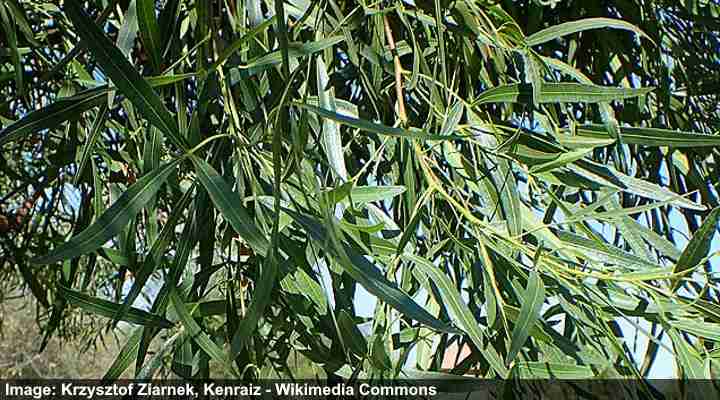
African sumac leaves
African sumac trees grow between 20 and 30 ft. (6 – 9 m) tall and wide. If the tree gets plenty of water, it grows fast at a rate of 24” (60 cm) per year. However, the sumac is tolerant of dry, arid conditions.
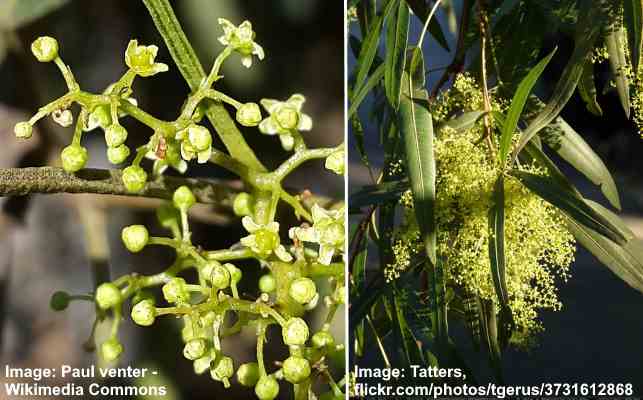
African sumac flowers
African sumac tree only grows in USDA zones 9 through 11. The drought-tolerant African sumac tree grows best in hot, full sun. Unlike most sumac trees native to the US, the African sumac has dense evergreen foliage. This growth feature makes the tree excellent as a shade tree or windbreak.
Here are some other varieties of sumac trees and shrubs
Sugar Sumac (Rhus ovata)—A small tree or shrub with large green, ovate leaves folded at the midrib. The ‘sugar bush’ has beautiful pink and white flower clusters appearing in spring. This tough, low-maintenance tree grows 4 to 10 ft. (1.2 – 3 m) tall and wide. Rhus ovata is suitable for USDA zones 7 to 11.
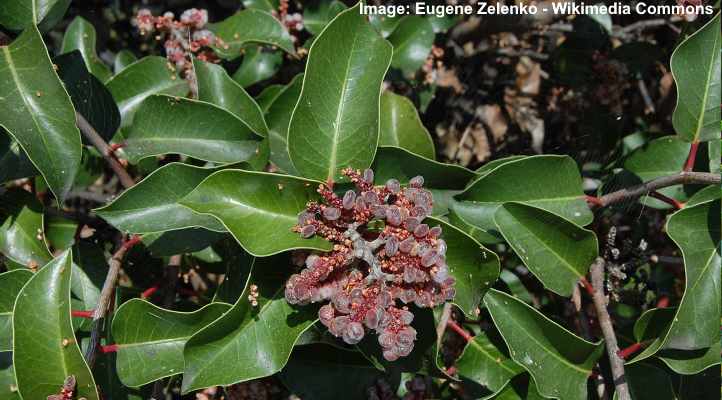
Sugar sumac (Rhus ovata) leaves and fruit
Elm-Leaved Sumac (Rhus coriaria)—Also named Sicilian sumac or Tanner’s sumac, this large shrub has characteristic pinnate sumac leaves. It’s prized as a landscape tree for its brilliant red fall foliage and clusters of edible red berries. Elm-leaved sumac grows in USDA zones 9 and 10.
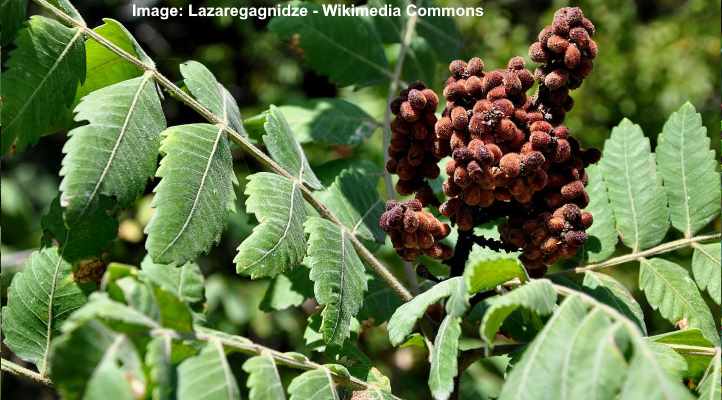
Elm-Leaved sumac (Rhus coriaria)
Littleleaf Sumac (Rhus microphylla)—This sumac species has the smallest leaves from all the plant varieties in the genus Rhus. Clusters of tiny, leathery pinnate leaves turn an attractive rose color in the fall. White flowers and orange-red berries also identify this decorative landscape shrub. Also called the desert sumac, the plant grows up to 15 ft. (4.5 m) in USDA zones 6 to 10.
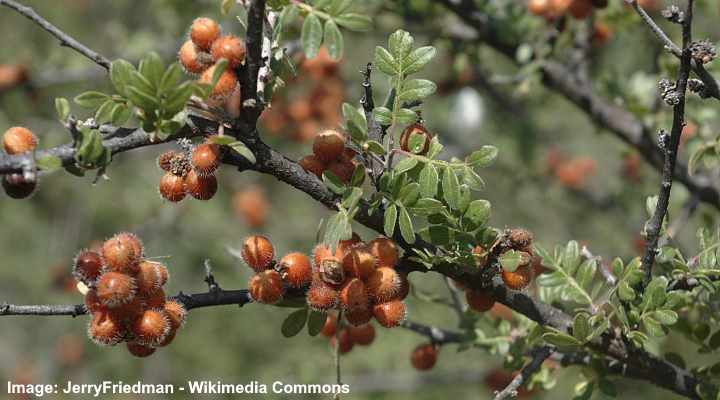
Littleleaf sumac (Rhus microphylla)
Prairie Sumac (Rhus lanceolata)—This small ornamental tree or large shrub has long, pinnately compound leaves that turn fiery red in the fall. Also called the flameleaf sumac or prairie flameleaf, the landscape plant has greenish-white flowers and dark red fruits.
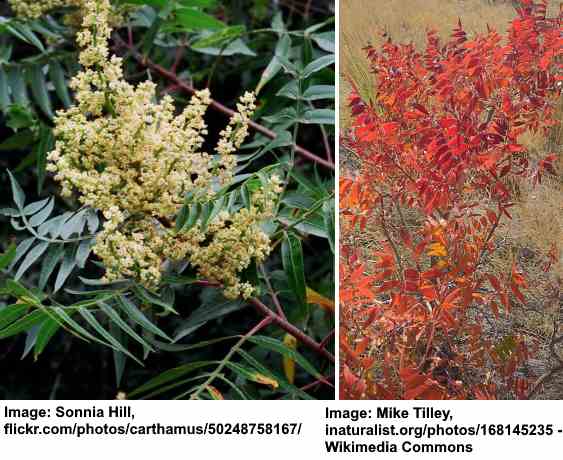
Prairie Sumac (Rhus lanceolata) flowers and autumn foliage
Related articles:
